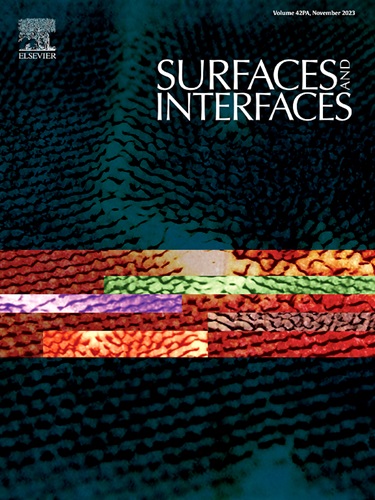通过 "一石二鸟 "策略构建掺杂 CNT@K+- 的 δ-MnO2 以实现高倍率和稳定的水性锌离子电池
IF 5.7
2区 材料科学
Q2 CHEMISTRY, PHYSICAL
引用次数: 0
摘要
层状二氧化锰(δ-MnO2)因其作为锌离子水电池阴极材料的巨大潜力而备受关注。然而,δ-MnO2 在商业应用中的广泛采用仍受到一些挑战的阻碍,如导电性不足以及在充放电循环中结构完整性不稳定。在本研究中,使用 KOH 溶液作为蚀刻剂,成功制备了 CNT@K+ 掺杂的 δ-MnO2(CNT@KMO),其中 CNT 通过建立导电网络增强了电子传输,而 KOH 中的 K+ 则作为支柱插层到 MnO2 夹层中,从而产生了更稳定的结构。因此,CNT@KMO 电极在 2 M ZnSO4+0.2 MnSO4 水电解液中以 0.5 A g-1 的电流密度循环 150 次后,显示出 306.1 mA h g-1 的理想可逆比容量。此外,在电流密度为 5 A g-1 时,该电极的比容量为 100.8 mA h g-1,库仑效率接近 100%,循环稳定性超过 2000 次。这种新颖的合成策略可为制造优质的锌离子水电池铺平道路。本文章由计算机程序翻译,如有差异,请以英文原文为准。

Construction of CNT@K+- doped δ-MnO2 by “killing two birds with one stone” strategy toward high-rate and stable aqueous zinc-ion batteries
Layered manganese dioxide (δ-MnO2) has garnered significant attention due to its exceptional potential as a cathode material in aqueous zinc-ion batteries. Nevertheless, the widespread adoption of δ-MnO2 in commercial applications remains hindered by challenges such as insufficient electrical conductivity and instability in its structural integrity throughout charge and discharge cycles. In this study, using KOH solution as the etchant, CNT@K+-doped δ-MnO2 (CNT@KMO) was successfully fabricated, where the CNTs enhance the transport of electron by establishing a conductive network, while the K+ from KOH serves as pillars to intercalate into the MnO2 interlayer, giving rise to a more stable structure. Consequently, the CNT@KMO electrode demonstrates an ideal reversible specific capacity of 306.1 mA h g-1 after 150 cycles at a current density of 0.5 A g-1 in a 2 M ZnSO4+0.2 M MnSO4 aqueous electrolyte. Furthermore, the electrode exhibits a respectable specific capacity of 100.8 mA h g-1 with a coulombic efficiency close to 100% at a current density of 5 A g-1 and exceptional cycling stability more than 2000 cycles. This novel synthesis strategy could pave the way for superior aqueous zinc ion batteries.
求助全文
通过发布文献求助,成功后即可免费获取论文全文。
去求助
来源期刊

Surfaces and Interfaces
Chemistry-General Chemistry
CiteScore
8.50
自引率
6.50%
发文量
753
审稿时长
35 days
期刊介绍:
The aim of the journal is to provide a respectful outlet for ''sound science'' papers in all research areas on surfaces and interfaces. We define sound science papers as papers that describe new and well-executed research, but that do not necessarily provide brand new insights or are merely a description of research results.
Surfaces and Interfaces publishes research papers in all fields of surface science which may not always find the right home on first submission to our Elsevier sister journals (Applied Surface, Surface and Coatings Technology, Thin Solid Films)
 求助内容:
求助内容: 应助结果提醒方式:
应助结果提醒方式:


